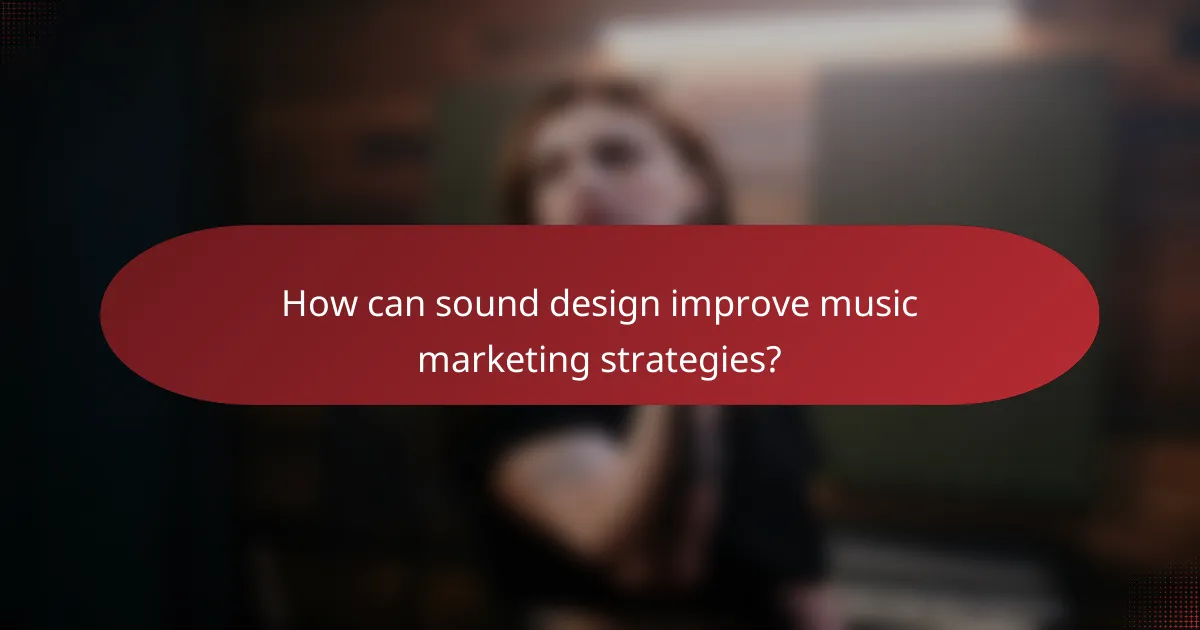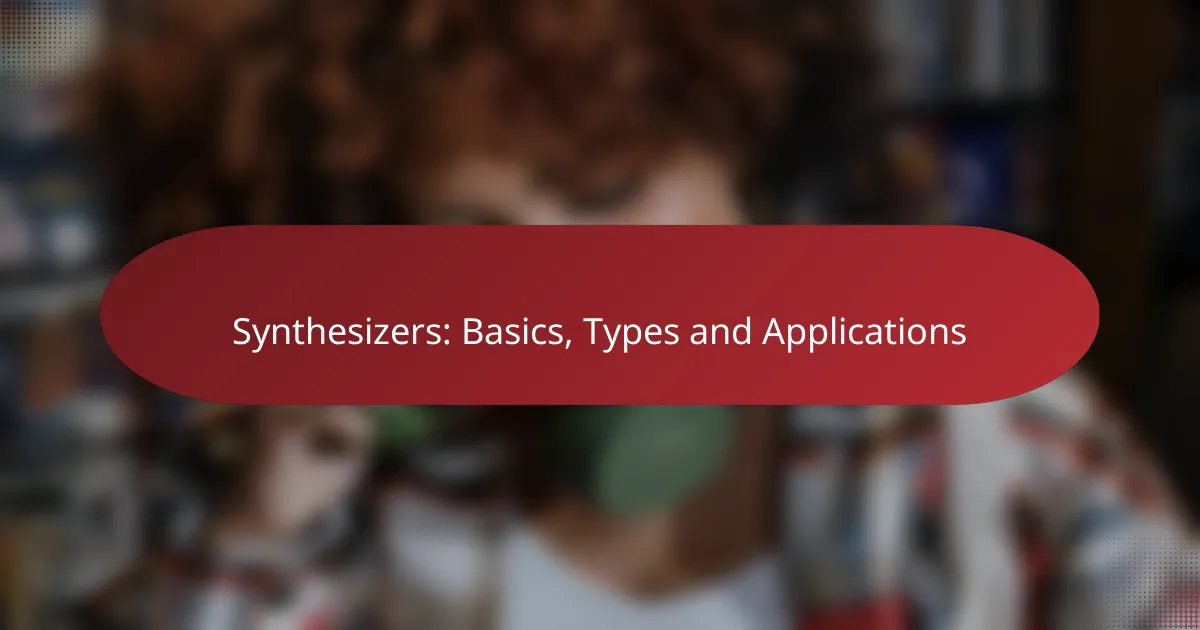Sound design plays a pivotal role in modern music production, as it shapes the aesthetic and emotional depth of a track. By creating and manipulating audio elements, sound design enhances the listener’s experience, making it an essential component of contemporary music. Current trends highlight the integration of technology, such as artificial intelligence and immersive audio, alongside traditional techniques to push creative boundaries.

How does sound design impact modern music production?
Sound design significantly influences modern music production by shaping the overall aesthetic and emotional resonance of a track. It involves the creation and manipulation of audio elements that enhance the listener’s experience, making it a crucial aspect of contemporary music creation.
Enhances emotional connection
Effective sound design can evoke strong emotions, making music more relatable and impactful. By carefully selecting sounds, producers can create atmospheres that resonate with listeners, whether it’s the warmth of a synth pad or the sharpness of a snare hit.
For example, using minor keys and dissonant sounds can create tension, while major keys and harmonious tones often evoke feelings of joy. Understanding the emotional weight of different sounds can help producers craft tracks that connect deeply with their audience.
Shapes genre identity
Sound design plays a pivotal role in defining the identity of various music genres. Each genre has characteristic sounds and production techniques that help distinguish it from others, such as the heavy bass in dubstep or the intricate layering in pop music.
Producers should study genre-specific sound palettes and techniques to effectively convey the desired style. For instance, using vintage synthesizers can give a track a retro feel, while modern digital tools can create a polished, contemporary sound.
Improves production quality
High-quality sound design enhances the overall production quality of a track, making it more professional and polished. This involves attention to detail in sound selection, layering, and mixing to ensure clarity and balance in the final product.
Producers should focus on using high-fidelity samples and plugins, as well as employing techniques like EQ and compression to refine their sounds. Avoiding common pitfalls, such as over-processing or cluttering the mix, is essential for achieving a clean and impactful sound.

What are the latest trends in sound design for music?
The latest trends in sound design for music emphasize innovation through technology, blending traditional methods with modern techniques. Key developments include the use of artificial intelligence, immersive audio technologies, and a resurgence of vintage synthesis methods.
Use of AI in sound creation
Artificial intelligence is transforming sound design by enabling musicians to generate unique sounds and compositions. AI algorithms can analyze vast amounts of data to create music that mimics various styles or even generates entirely new genres.
Producers can use AI tools to automate repetitive tasks, such as mixing and mastering, allowing them to focus on the creative aspects of music production. However, relying too heavily on AI can lead to a lack of personal touch in the final product.
Integration of immersive audio technologies
Immersive audio technologies, such as Dolby Atmos and spatial audio, are becoming increasingly popular in music production. These technologies create a three-dimensional sound experience, allowing listeners to feel as if they are inside the music.
To effectively integrate immersive audio, producers should consider the placement of sounds in a three-dimensional space. This requires a shift in traditional mixing techniques, as well as an understanding of how listeners interact with sound in an immersive environment.
Revival of vintage synthesis techniques
There is a growing interest in vintage synthesis techniques, with many producers seeking to recreate the warm, rich sounds of classic synthesizers. This trend often involves using analog equipment or software emulations that mimic the characteristics of vintage gear.
Producers should experiment with layering sounds and utilizing modulation techniques to capture the essence of vintage synthesis. While these methods can add depth and character to music, they may also require more time and expertise compared to modern digital techniques.

What techniques are essential for effective sound design?
Essential techniques for effective sound design include layering sounds, utilizing field recordings, and manipulating sounds with effects. These methods enhance the richness and uniqueness of audio in modern music production.
Layering sounds for depth
Layering sounds involves combining multiple audio tracks to create a fuller and more complex sound. This technique can enhance the depth of a mix, making it more engaging for listeners. For instance, layering a synth pad with a vocal sample can create a lush backdrop that supports the main melody.
When layering, consider the frequency spectrum to avoid muddiness. Use complementary sounds that occupy different frequency ranges, such as low bass layers combined with higher melodic elements. A common practice is to use two or three layers for each sound to maintain clarity while adding richness.
Utilizing field recordings
Field recordings capture real-world sounds and can add authenticity and texture to music. These recordings can range from urban noise to natural soundscapes, providing unique elements that enhance a track’s atmosphere. For example, incorporating sounds from a bustling city can evoke a sense of place and energy.
When using field recordings, ensure they are high quality and relevant to your project. Consider the context in which the sounds will be used, as they should complement the overall theme of the music. Additionally, be mindful of copyright issues; always obtain permission if using recordings from other sources.
Sound manipulation with effects
Sound manipulation through effects involves altering audio signals to create new textures and dynamics. Common effects include reverb, delay, distortion, and modulation, each offering unique ways to transform sounds. For example, adding reverb can create a sense of space, while distortion can add grit and character to a guitar track.
When applying effects, use them judiciously to enhance rather than overwhelm the original sound. A good rule of thumb is to start with subtle adjustments and gradually increase the effect until it achieves the desired impact. Experimenting with different combinations of effects can lead to innovative sound design outcomes.

What tools are popular for sound design in music production?
Popular tools for sound design in music production include software and hardware that enable musicians to create, manipulate, and refine sounds. Key options often feature synthesizers, samplers, and audio effects that enhance the overall production quality.
Native Instruments Komplete
Native Instruments Komplete is a comprehensive suite of virtual instruments and effects that caters to various sound design needs. It includes synthesizers, sampled instruments, and effects processors, making it versatile for different genres.
When using Komplete, consider its extensive library, which allows for deep customization of sounds. Users can layer instruments and effects to create unique textures, but be mindful of system requirements, as the full suite can be resource-intensive.
Ableton Live Suite
Ableton Live Suite is renowned for its intuitive interface and powerful sound design capabilities. It offers a range of built-in instruments and effects, along with the ability to manipulate audio in real-time, which is ideal for live performances and studio work.
Utilizing Ableton’s session view can help streamline the creative process, allowing for quick experimentation with loops and samples. However, beginners should take time to familiarize themselves with its features to avoid overwhelming complexity.
Waves Audio plugins
Waves Audio plugins are widely used for mixing and mastering, providing high-quality effects that enhance sound design. These plugins cover everything from equalization and compression to reverb and delay, making them essential tools for professional production.
When incorporating Waves plugins, focus on their ability to shape and polish sounds effectively. It’s advisable to use them judiciously to avoid over-processing, which can lead to a muddy mix. Regularly updating the plugins ensures compatibility and access to the latest features.

How can sound design improve music marketing strategies?
Sound design can significantly enhance music marketing strategies by creating distinctive audio identities that resonate with audiences. By integrating unique sounds and textures, artists can differentiate themselves in a crowded market and foster deeper connections with listeners.
Creating unique brand soundscapes
Developing a unique brand soundscape involves crafting specific audio elements that reflect an artist’s identity. This can include signature sounds, musical motifs, or even specific production techniques that become synonymous with the brand. For instance, a recognizable synth pad or a unique vocal effect can help listeners instantly identify an artist’s work.
To create effective soundscapes, consider the target audience’s preferences and the emotional tone of the music. Experimenting with various sound layers and textures can lead to a distinctive auditory experience that enhances brand recognition.
Enhancing listener engagement
Sound design plays a crucial role in enhancing listener engagement by creating immersive experiences that captivate audiences. Techniques such as spatial audio, dynamic mixing, and interactive sound elements can draw listeners in and keep them interested. For example, using panning effects or surround sound can make a track feel more alive and engaging.
To maximize engagement, focus on the emotional impact of sound design. Use contrasting dynamics, unexpected sound elements, or thematic audio cues to maintain listener interest throughout a track. Regularly soliciting feedback from fans can also guide sound design choices that resonate well with the audience.

What are the prerequisites for learning sound design?
To learn sound design, a foundational understanding of audio principles and software tools is essential. Familiarity with digital audio workstations (DAWs) and basic music theory can significantly enhance your learning experience.
Understanding audio fundamentals
Audio fundamentals include concepts such as frequency, amplitude, and waveforms. Grasping these elements is crucial for manipulating sound effectively. For instance, frequency determines pitch, while amplitude affects volume, both of which are key in sound design.
Another important aspect is understanding sound waves and their behavior. Sound travels in waves, and knowing how these waves interact with different environments can help you create more immersive audio experiences. Consider how reflections and absorptions can alter the sound in various spaces.
To get started, familiarize yourself with basic audio equipment and software. Experiment with recording techniques and sound manipulation tools. A simple checklist for beginners might include learning to use a DAW, understanding microphone placement, and exploring various sound synthesis methods.










